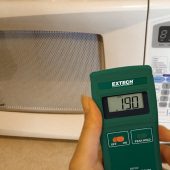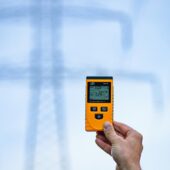Similar to most measuring instruments, all hygrometers lose their accuracy over time. This is a huge problem in situations where you need to maintain a tight humidity range such as in a cigar humidor, art gallery or egg incubator.
The actual relative humidity could be off by 2%, 5%, 10% or more compared to what the hygrometer is showing.
To ensure accurate humidity measurements, it’s important to regularly calibrate a hygrometer. Fortunately, that’s easy to do with most hygrometers using easy to find household items.
Causes of Inaccurate Hygrometer Readings
Here are the most common reasons why a hygrometer can become inaccurate.
- It just happens. No matter how well you take care of a hygrometer, it will lose its precision over time. This happens to most instruments and that’s why regular calibration is necessary even if an instrument has not been dropped or damaged.
- If you are using a hygrometer in a harsh environment such as outdoors, in extreme temperatures or in situations where it is subjected to frequent impacts, then it will lose its accuracy sooner and you’ll need to calibrate it more regularly.
- Serious damage to a hygrometer from impact (e.g. an accidental drop) or exposure to extreme heat or cold can damage the internal components and throw off the hygrometer’s accuracy.
- The accuracy of a hygrometer can also drift if contaminants come into contact with the sensors. This can be physical contaminants like dust or chemical contaminants like acid that damage the sensors.
How Can You Tell If A Hygrometer is Inaccurate?
If, for some reason, you suspect the reading from your hygrometer is off, it’s a good idea to calibrate it. Even if it turns out to be accurate, calibration doesn’t hurt.
Another option is to compare its reading with that of another hygrometer, ideally one that has been recently calibrated. Compare multiple measurements from each hygrometer to get an idea of how far accuracy has drifted.
Note: Keep in mind that all hygrometers have a margin of error. So if the reading of the two hygrometers differ by 3% or less, it’s probably accurate.
In extreme cases where precision has gone off the rails, you’ll be able to tell the hygrometer is off. You can feel that the room is drier or more humid than the hygrometer suggests. Do a calibration to make sure it’s not just you.
If you are using a hygrometer to preserve something like cigars, rare books or antique furniture, there will be signs that the hygrometer is lying to you.
For instance, it may show a 70% relative humidity but your cigars feel dry and brittle. Or it may show low humidity but there are signs of mould on furniture and walls.
4 Ways to Calibrate a Hygrometer
Here are the four options you have when it comes to calibrating a hygrometer.
The Salt Method
Most hygrometers, both digital and analog, give users the option to adjust calibration through a small screw at the back for analog models or via a menu for digital hygrometers.
Check if yours allows calibration. Check the user manual or contact the manufacturer to confirm. If it doesn’t, you will not be able to calibrate the hygrometer yourself. Skip to the next section below on what to do if you cannot calibrate your hygrometer.
But if you can calibrate it, the best way to do it is using the salt method. It is a bit slow but it’s easy to do and doesn’t require you to buy anything.
Here are the steps to follow:
- Get a bottle cap and fill it with a teaspoon of table salt.
- Add a few drops of distilled water to the bottle cap, just enough to form a pasty mixture. You don’t need to dissolve the salt. The more water you add, the longer the calibration will take.
- Place the bottle cap and the hygrometer inside an airtight ziploc bag or container. Place the bag or container somewhere where temperature will stay fairly constant such as in the closet or a kitchen drawer.
- Wait 8 hours then check the reading on the hygrometer. It should indicate a relative humidity of 75%. If it is higher or lower than this, adjust the hygrometer until it reads 75%. If you want, you can return it to the bag to make sure it holds that reading. That’s it, you have calibrated your hygrometer.
Here’s a helpful video if you need more guidance.
So what’s the science behind the salt calibration method? Why are we so sure relative humidity inside the bag or container is 75%?
The principle behind this method is equilibrium humidity.
Salt is hygroscopic, meaning that it attracts/absorbs water. When you have a concentrated solution of salt in a closed, temperature-constant environment, it gradually reaches equilibrium humidity which is 75%.
If humidity rises above 75%, the salt absorbs water vapour, thus bringing the humidity back down. If humidity drops below 75%, water in the solution evaporates, again raising the humidity back to 75%. After 6-8 hours, the relative humidity stabilises at 75%.
The Damp Cloth Method
Another option is to wrap the hygrometer in a damp cloth for about half an hour to an hour. Then quickly open the cloth and check the reading on the hygrometer. It should be between 95% and 98%. If not, adjust the hygrometer accordingly.
You have to be quick reading the hygrometer since exposure to ambient air will cause the hygrometer to show a lower reading.
A more accurate way to carry out this process is putting a damp cloth along with the hygrometer in an airtight transparent bag, similar to the salt method. After about an hour, check the reading on the hygrometer without taking it out of the bag.
It should show a humidity of 95-98%, but anywhere between 95% and 102% is acceptable considering that hygrometers have a margin of error.
Using a Calibration Kit
You can also get a calibration kit like this one from Boveda that comes with everything you need to calibrate a hygrometer at home.
They have a pack for calibrating your hygrometer to 32% and another for 75% calibration.
For added precision, get both kits and carry out a 2-point calibration. But for most home applications a single point calibration is adequate.
Using a Calibration Lab
If you work in a lab, museum or some other industrial or commercial setting, you may be required to use third party services to calibrate a hygrometer.
This ensures the best accuracy. Third party calibration usually also comes with a calibration certificate to prove that the hygrometer is accurate.
What If I Cannot Calibrate My Hygrometer?
If you cannot calibrate your hygrometer, there is a simple solution that lets you keep using it. You simply need to note its deviation from the right reading.
Carry out the salt test as it produces the most precise level of humidity. Check what reading the hygrometer displays and subtract it from the 75%. Apply this deviation whenever you take readings in the future.
So if the hygrometer read 70% humidity, that’s a 5% deviation. Remember to add 5% to any future measurements. If it reads 80%, take away 5% from future measurements.
When Should You Calibrate A Hygrometer
You should calibrate your hygrometer at least once a year even if you think it is still accurate. If you use it very often or operate it in a harsh environment, calibrate it at least twice a year.
It’s also a good idea to calibrate the hygrometer more regularly, 2 or 3 times a year, if you use it for sensitive applications where precision is crucial.
In between these regular calibrations, you should also calibrate a hygrometer if:
- It falls or sustains some kind of impact.
- It’s been exposed to extreme temperatures even if it is for a short period.
- It’s been transported over a long distance.
How To Take Care of A Hygrometer
To keep the hygrometer as accurate as possible, only use it within the recommended environmental parameters, especially temperature. Check the manual for the max and min temperature the hygrometer can be stored or operated in.
When storing or transporting the hygrometer, put it in its own protective case. Do not put it in a tool box or store it alongside other items that could damage it.
Finally, avoid exposing the hygrometer to the elements. Direct sunlight, dust, rain and other elements can damage the sensors on a hygrometer.


